For many of us visual observers, traveling hundreds of miles to dark skies is a relatively common activity. We leave the vast urban and suburban landscapes behind, looking for any dark corners to glimpse the universe from.
My love of the open road has made this activity enjoyable. I derive an immense amount of satisfaction from getting myself from A to B in a personal vehicle. The freedom, responsibility, and capacity to see new places has always excited me. I took my driver’s test at 15.5 years old and waited several months until my 16th birthday to get my license. Despite this apparent love of travel, I’d never made it to Western North America’s high desert climates, regions offering superb transparency and darkness for observing. Between work, school, and life, there’s always been an excuse. “I’ll do it when I graduate”, “Maybe when my contract position goes full-time”, “Someday I’d like to get out there”.
In early June, I was busy going through the motions. As I flipped through feeds, an email from a local astronomy club member caught my attention. He was informing the group about this wonderful website called Adventures in Deep Space; you may have heard of it. I excitedly chimed in about my recent observing report on the site. After exchanging a few emails, he suggested that I join them at the Okie Tex Star Party in Oklahoma’s Panhandle. Initially, I shrugged it off, stating that I’d love to do it someday. But then I stopped. Why not now? I’d never taken a week off, but work was going to be relatively slow in late September. After looking through the Okie Tex website, I made an impulsive decision to book my registration.
I now had several months to prepare, and I had lots of work to do. I’d done plenty of local astronomy camping, but it was always a means to an end. I’d observe all night and crash under a cheap truck bed tent before driving home. Camping was an afterthought. This trip would require better provisions. After researching many pickup truck camping setups, I settled on the versatile and affordable Softtopper shell for my trusty old 2005 regular cab Tacoma. After testing it on a few local trips, I realized that my sleeping platform wasn’t up to the job, so I invested in new foam bedding materials. After much prep work, it was time to hit the road.
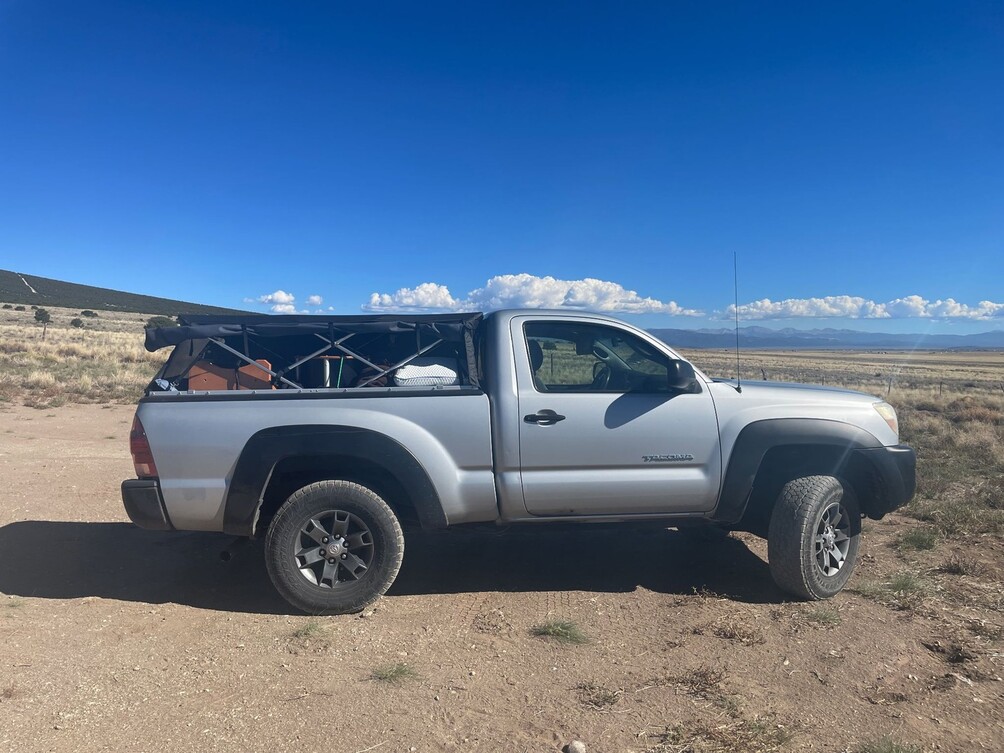 My truck camping setup with my 15” Obsession Classic under the soft
topper
My truck camping setup with my 15” Obsession Classic under the soft
topper
My plan was relatively straightforward. I was going to leave on a Friday afternoon to drive about 250 miles to Southwestern Indiana. The next day, I’d make it to Central Kansas. On Sunday afternoon, I was to finally arrive at Okie Tex for four nights of fantastic group observing with several Michigan club members. The latter half of the week was to be spent camping with my uncle in the San Luis Valley of Colorado, and my dad made a last-second decision to join us for some mountain camping before riding back east with me.
That was the plan anyway, and it all started perfectly on schedule. After stopping at my 2024 total eclipse site, a park in Defiance, Ohio, I camped near Lafayette, Indiana. The next day was all about crushing the miles. After driving across Missouri, I enjoyed the Flint Hills during sunset, making it comfortably over 620 miles to a free lakeside campground south of Junction City, Kansas. Sunday was my final day on the road, and it was an easy drive through the relatively empty grasslands of Southwestern Kansas. I was well off the interstate, moving southwest to the Panhandle.
I had made it to my first star party, and I was immediately met with a magical sight. The rocky cliff faces of Black Mesa towered over the observing field on all sides. As the late afternoon lighting shifted, the sun cast new reflections and shadows between the rocks. It was a truly unique biome, featuring cacti, desert wildflowers, and familiar grasslands. Recent rainfall had left the field dust-free and the vegetation green. Looking around, my 15” Obsession was in good company. Our club was on the southern row of a massive observing field, and nearly all of the surrounding campers had large Dobsonians parked along their rows.
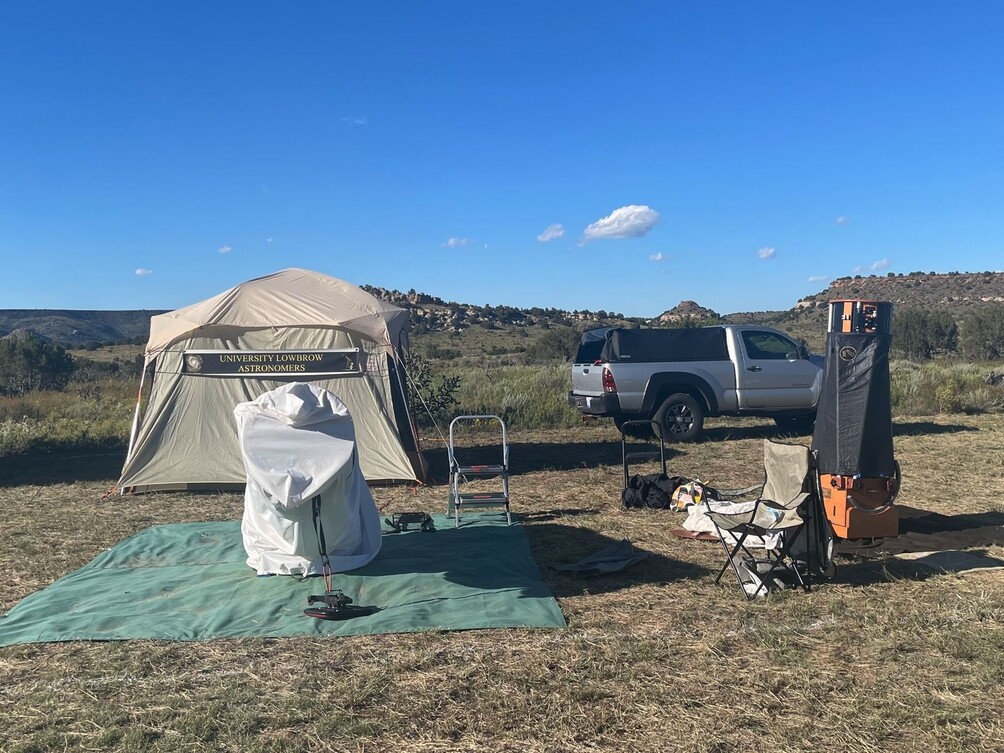 My 15-inch Obsession in the University Lowbrow Astronomers row at
Okie-Tex
My 15-inch Obsession in the University Lowbrow Astronomers row at
Okie-Tex
It was finally time for nightfall. The chatter on the observing field slowly decreased as true dark set in. Despite an estimated 300 people, the field was pitch black, aside from a few red lights. I immediately grasped the 36.8-degree latitude. Scorpio and Sagittarius were high over the mesa, allowing access to many new DSOs without muddiving
Some of my favorite observations:
The atmosphere throughout the night was like nothing I’d ever experienced. Hundreds of dedicated observers and imagers silently practiced their craft, stopping occasionally to compare views and share laughs.
I was out of gas at 3:00. It had been a long few days, and transparency was rapidly reducing with the arrival of a cloud deck. Several of my fellow Michiganders continued to observe even when 95% of the sky was covered. I admired their dedication!
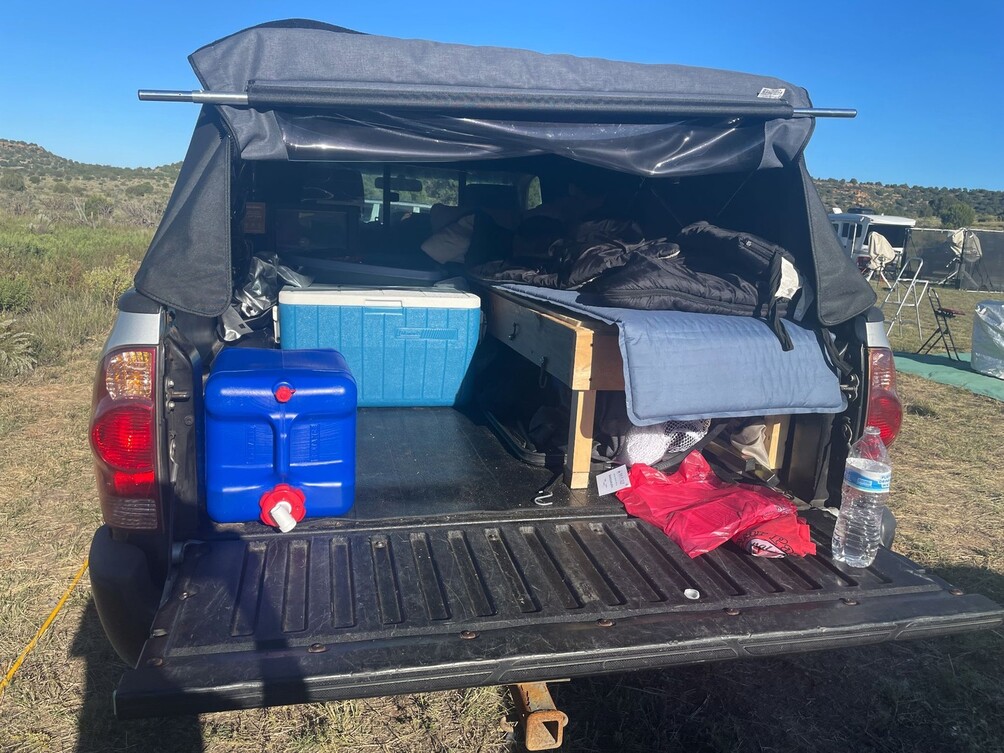 My grandpa and I put together this camping setup in preparation for
Okie-Tex. It was tight but cozy.
My grandpa and I put together this camping setup in preparation for
Okie-Tex. It was tight but cozy.
After a nice sleep, it was time to explore the star party during the day. A nearby camper was walking around with a tarantula on his cooler, looking for a place to set it down. I had many great discussions with nearby observers, and I enjoyed the air conditioning within Camp Billy Joe’s mess hall.
Monday night was…interesting. An unforecasted thunderstorm lingered ominously in the distance. The lightning was incredible, but the winds were slowly increasing across the open valley. My camping setup deflected the elements, but I awoke many times due to the noise.
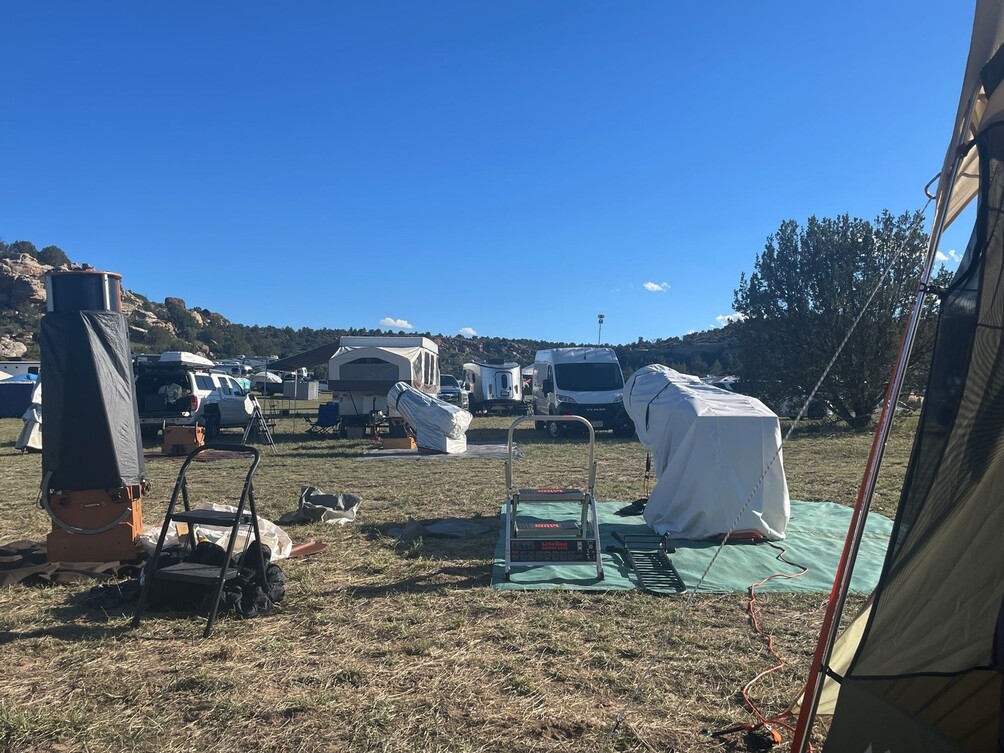 Another view of Okie-Tex from my camp
Another view of Okie-Tex from my camp
The forecast for Tuesday wasn’t looking good either. I was scheduled to leave the star party on Thursday to camp with family in the San Luis Valley of Colorado, so I made a last-minute decision to head to the Sangre de Cristo Mountains of New Mexico on Tuesday afternoon in pursuit of clear skies. I had driven way too far for only two nights of observing opportunity.
It was hard to leave the camaraderie of the star party, but I headed west along the desolate and beautiful lands of New Mexico. The distances were vast, and the population incredibly sparse. After two hours, I was deep in the mountains, climbing through the pine forests to 7,500 feet. I arrived at my campsite, Rio Grande National Monument, at 6:00. In an incredible stroke of good luck, a site was open overlooking the canyon without any nearby neighbors. I had a perfect southern horizon and ridiculously good transparency. The dark lanes of our galaxy punched through the sky vibrantly, like an oily black pen spilled across a white paper of unresolved stellar glow. It was unbelievably beautiful, and I observed many faint objects from 7,500 feet over the Rio Grande:
-
NGC 7549 “Interesting galaxy. It had a very bright core that tapers gradually. Across its surface, there are hints of mottling, especially near the core. I cannot trace any outer structure. -
NGC 7550 “Small, round, quite dim with low surface brightness across.” -
NGC 7547 “A dim and round galaxy that has an even surface brightness.”
Here’s an annotated image that shows the knot, lane, and outer structure. I was pretty skeptical about the crossing lane, but it was there with averted vision and careful study over the course of the hour at 330x.
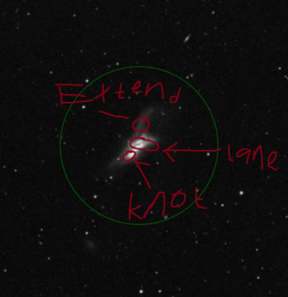 NOTE: The picture credit belongs to The Sky Live. Please check out the
original at:
https://theskylive.c...y/ngc520-object
NOTE: The picture credit belongs to The Sky Live. Please check out the
original at:
https://theskylive.c...y/ngc520-object
I’ve rotated the field to capture what I saw at 1:30 AM. I suspect this
would be a tough observation to duplicate with a 15” outside of a
7,500-foot altitude location; the transparency is unreal up there!
Cave Nebula (
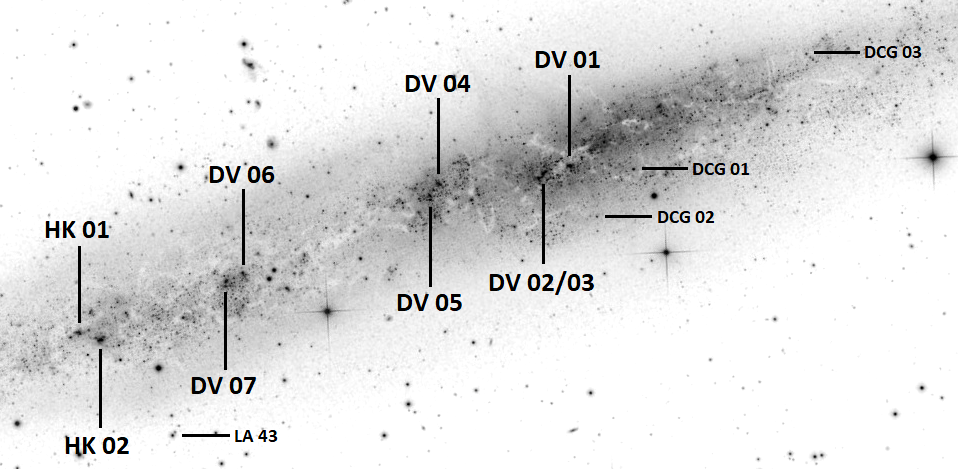 Finder chart for objects in NGC 55 by Scott Harrington. Original photo by Mark Hanson.
Finder chart for objects in NGC 55 by Scott Harrington. Original photo by Mark Hanson.
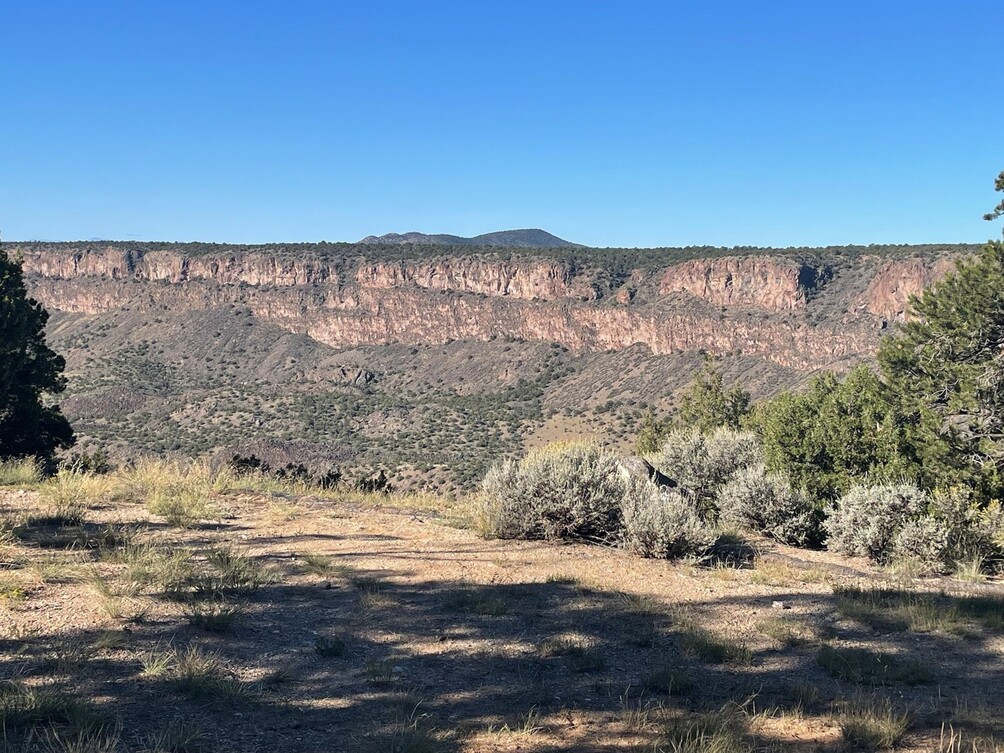 My observing site in New Mexico’s Rio Grande National Monument
My observing site in New Mexico’s Rio Grande National Monument
After two nights at 7,500 feet, I knew why the professionals place their observatories at high elevations. The transparency was unreal. It’s hard to place these conditions into words, and I spend a good amount of time under dark skies in the northern lower peninsula of Michigan.
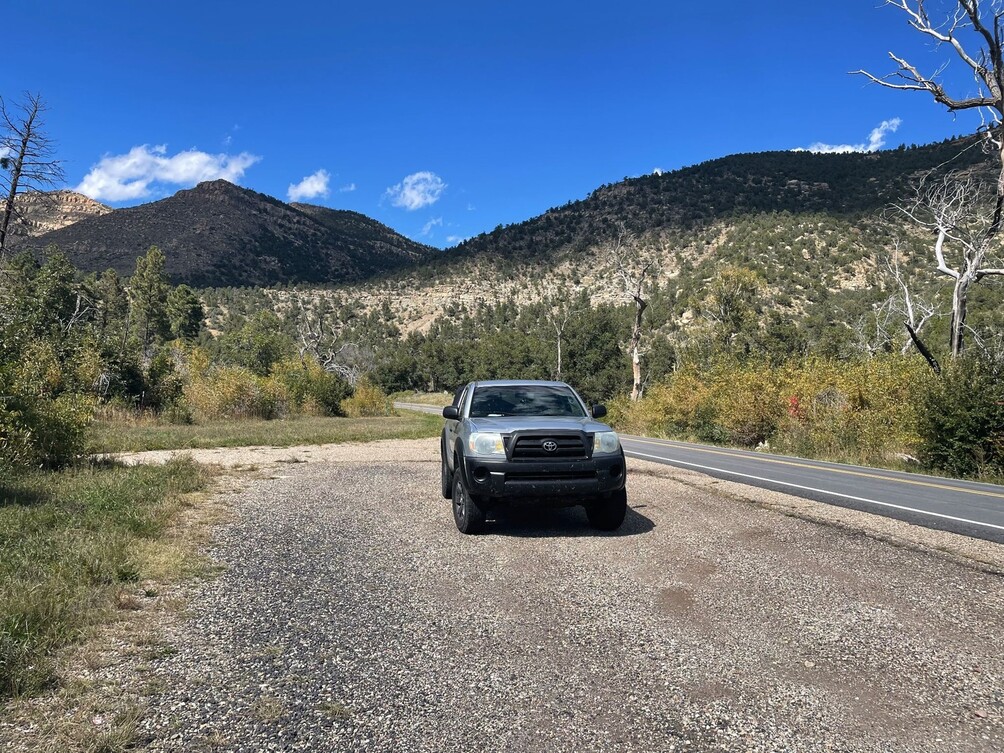 Crossing the Sangre de Cristo Mountain Range in New Mexico
Crossing the Sangre de Cristo Mountain Range in New Mexico
It had been two epic days of remote solo camping, and I was looking forward to familiar faces. Two hours of gorgeous desert roads were all that it took to finally arrive in Colorado, and I sat waiting at a set of coordinates south of Great Sand Dunes National Park in public BLM land. The San Luis Valley had immediately captivated me on my drive in. This vast and arid plain was surrounded by impressive towering peaks on all sides. It was incredibly beautiful. After a quick nap, I saw a pumpkin orange Tacoma coming down the dirt road. My dad, uncle, and his girlfriend had found me!
We talked, laughed, and ate some delicious Chili. Moonset over the peaks was beautiful, as was the distant glow of the Rio Grande River across the valley when the setting sun caused the water to reflect brightly. The day and night views alongside Blanca Peak were quite spectacular, but distant light pollution was worse than in Okie-Tex or New Mexico. I had fun showing my family members many bright DSOs, such as structure in the Andromeda/Triangulum galaxies and M13. When they went to bed, I still had a few hours of energy left in me to observe more difficult objects before crawling into the truck when the wind picked up around 1:00 AM.
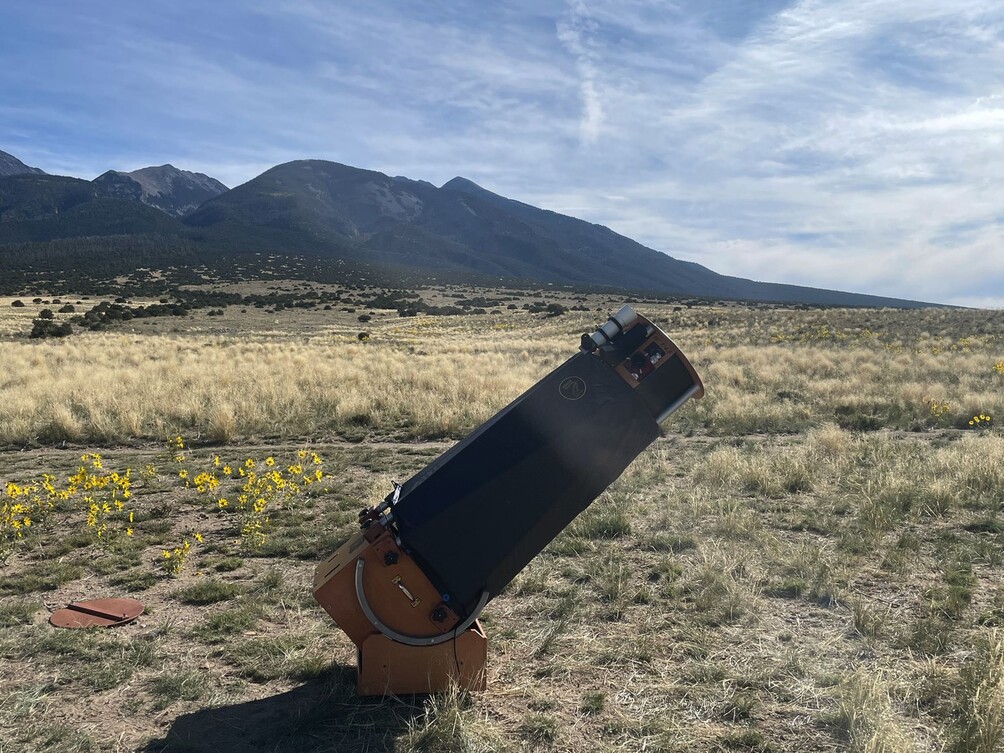 My telescope amidst the beautiful scenery in the San Luis Valley
My telescope amidst the beautiful scenery in the San Luis Valley
Some highlight objects from nearly 8,000 feet in the San Luis Valley:
The Cetus Dwarf was unbelievably tough and annoying to pull off. Appearing as a small puff that was slightly brighter in the center, I only knew that it was detected based on the star field. It took around an hour to convince myself that I wasn’t seeing a faint star or other object. It was there, but just barely.
I had been on the road for 7 days. My dad and I hit one more incredible BLM campsite just south of Leadville, Colorado, deep in the mountains on Friday night. It was the most gorgeous campsite of the whole trip, located in a valley surrounded by massive peaks. As the sun set over the cloudy sky, the evening light cast its illumination on the peaks like spotlights on art gallery paintings. The view was simply breathtaking, quite literally since we were all the way up above 9,000 feet! Looking at the forecast for down the mountain in Buena Vista, it was only going down to 50 degrees Fahrenheit, a comfortable night compared to my New Mexico mid-30s lows. This was a good revelation since my Dad’s last-minute tent wasn’t designed for winter weather, featuring a rain fly that had a massive gap on the door. If you’ve spent time in the mountains, you can already see the problem. Elevation and mountain air currents can make the weather very different in localized areas. We both awoke feeling quite cold, and I was almost glad that it had been cloudy the night before to remove any observing temptations. Both of our respective camping setups were covered in a deep layer of frost. My Dad said it was his coldest night in a tent ever, an impressive record since he has hiked and slept in the bottom of the nearby Black Canyon dozens of times with my uncles. Even with the extra insulation of the canvas truck top, I didn’t fare much better since my sleeping bag isn’t rated for sub-freezing temps. Despite this challenge, we both agreed that the surrounding views were worth it.
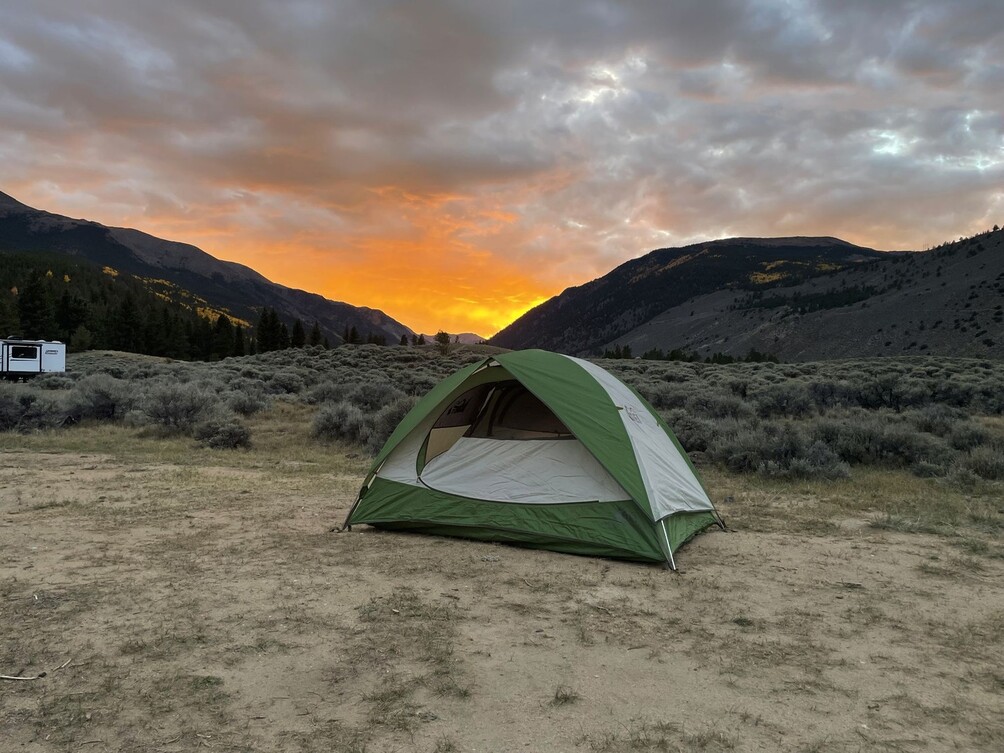 Our campsite south of Leadville, CO
Our campsite south of Leadville, CO
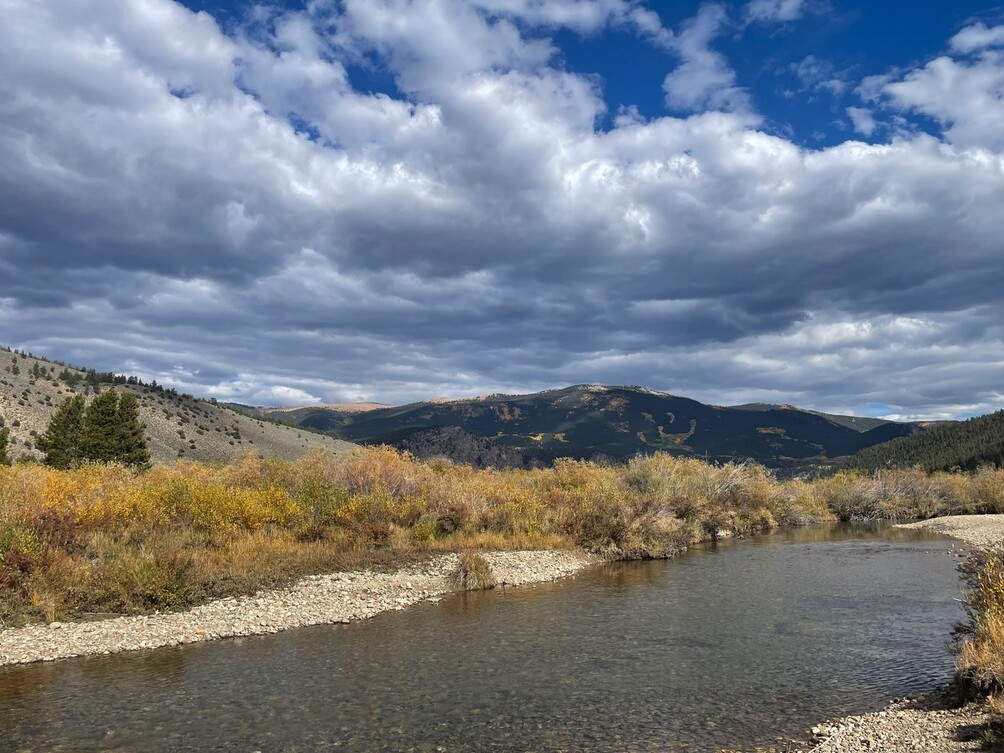 The views south of Leadville, CO.
The views south of Leadville, CO.
The entire drive from Alamosa to Denver was just phenomenal. My little 157-horsepower truck rumbled diligently up to 11,100 feet, the highest point of the Interstate network on I-70’s Eisenhower Tunnel. It complained the whole way through, struggling to maintain 55 mph in third gear. It was a challenging and rewarding drive, and the yellow (fall colored) aspens stretched far above, stopping sharply below the summits on all of the great 14,000-foot peaks. Every corner yielded another picture-perfect view. I enjoyed the challenge of mountain driving, especially in an underpowered yet capable little Toyota. I was so proud of her for taking us up and down those peaks. Colorado was just unbelievable, and I immediately understood why so many people had flocked there despite the challenging terrain and crowding.
Just when the excitement seemed over, an unsettling clunk appeared after a 780-mile day to Des Moines, Iowa, my first hotel on the entire trip. We figured the floating brake pads were moving more as a result of the desert two-track roads, a known Tacoma issue, so we hit the road the next morning. This was a mistake. Both front wheel bearings were shot. We tried to limp to Iowa City on US-6 but towed the truck 20 miles out. I couldn’t believe our luck. It was a Sunday afternoon, and we had found a tow truck in under an hour. What’s more, we found the most honest mechanic imaginable. He quickly placed my truck at the front of his to-do list. My dad and I hung out in the nice town of Iowa City, enjoying some good food and drinks at an Irish pub downtown. We watched the Lions and reflected on the exciting morning. Before I knew it, both bearings were replaced for a very fair price. I was glad this issue didn’t happen in remote New Mexico, and it was a valuable lesson to replace old maintenance items on my truck before the next long trip. It nearly doubled my trip costs, though! Back on the road at 5:30, we pushed hard through the night, taking turns swapping drivers every few hours. I did the last stint through Chicagoland and across Michigan. We finally arrived at my parents’ house at 1:30 AM.
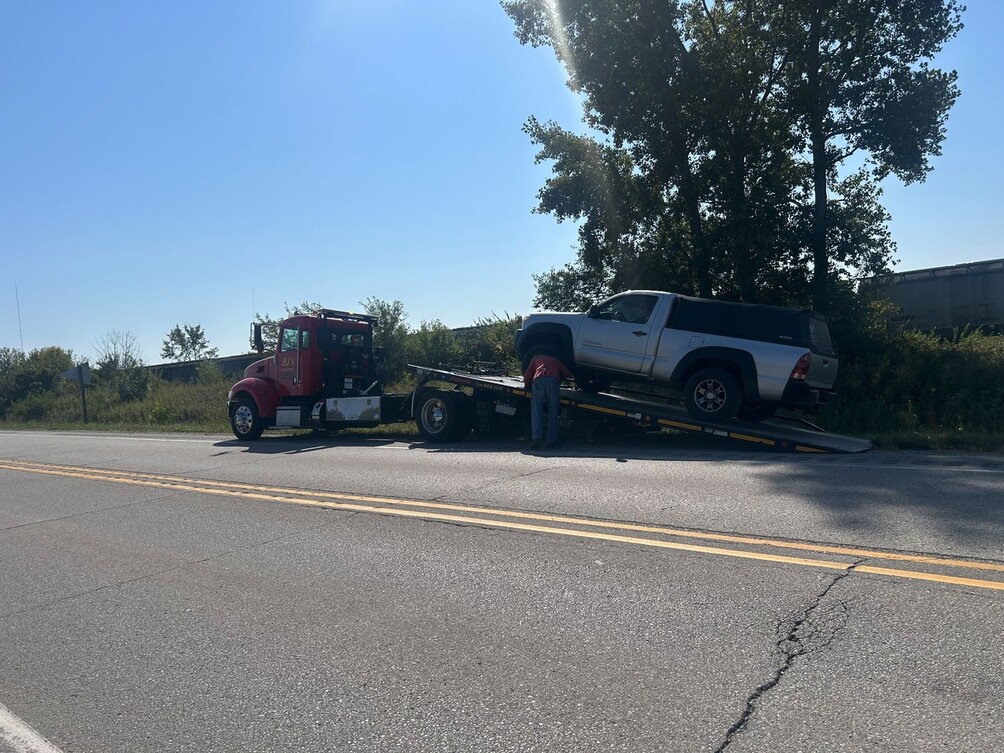 Whoops!
Whoops!
This trip taught me many lessons. I’m capable of solo camping for over a week at a time, and I actually enjoy the camping element now! It also made me aware of how privileged we are in the U.S. There is so much public land out there, especially in the West. While more 3,000-mile trips are certainly in my future, I’m going to frequent my local public lands here in Michigan. I’m also hoping to get West of the Mississippi on a more consistent basis, maybe every other year. The breakdown doesn’t bother me in the slightest. Adventures are bound to have challenges, but the old truck did a great job all things considered. I can’t fault her for shedding wheel bearings after 206,000 trouble-free miles. The $300 tow bill was quickly covered by my insurance as well. I’m glad that I added that option before leaving, just in case!
I experienced many twists and turns along this trip. Before I left, I would’ve never guessed that I would end up solo camping on top of a canyon in New Mexico, but that’s part of the fun. You never know where the adventure will lead. Astronomy and the pursuit of dark skies have made me a more adventurous person. I now realize how incredible it is to explore both the cosmos and our beautiful planet. If you find yourself in the U.S., you owe it to yourself to get into the vast and open expanses of the West. Big road trips like mine can be done for under $1,000 if you camp in public land while traversing the landscapes.
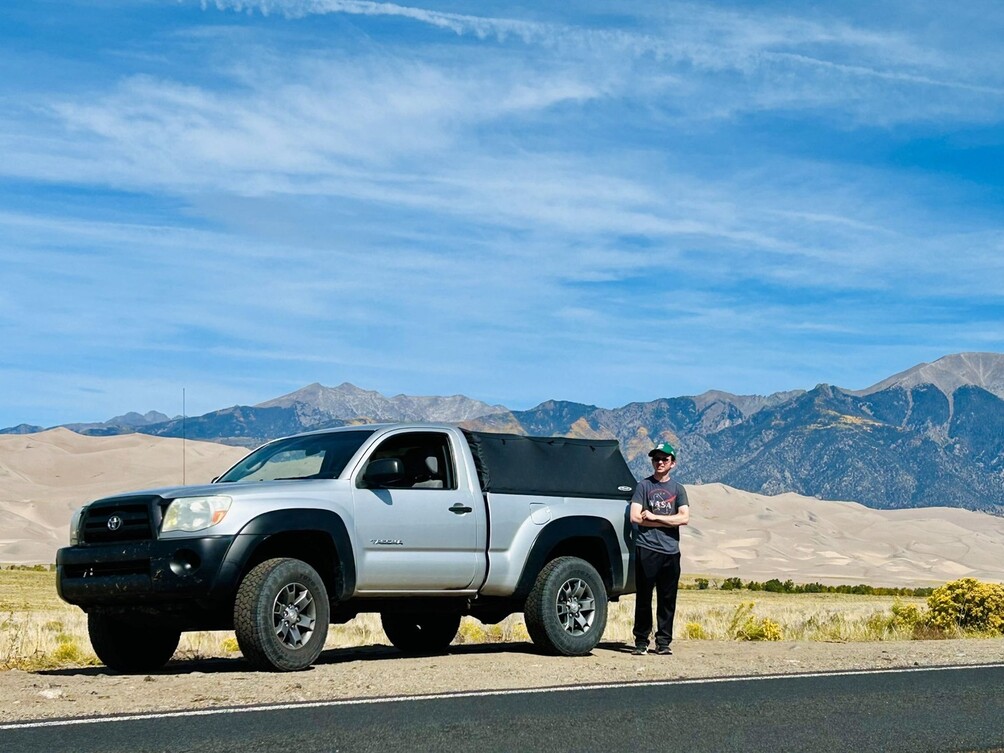 Leaving the incredible Great Sand Dunes National Park in Colorado
Leaving the incredible Great Sand Dunes National Park in Colorado